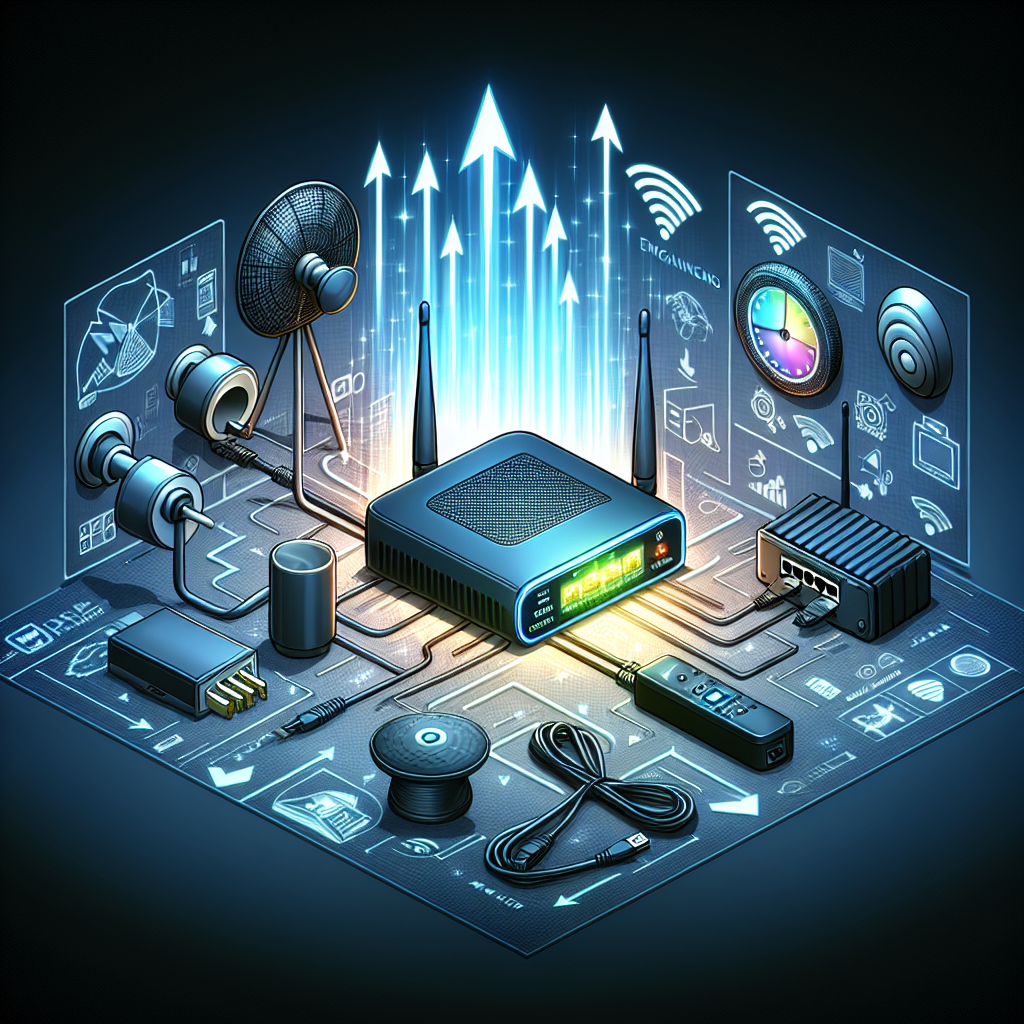Are you tired of dealing with slow internet speeds and constant buffering on your DSL connection? Looking to enhance your online experience and boost your internet signal for a smoother browsing experience? Look no further! In this guide, we will share tips and tricks on how to optimize your DSL internet signal for a faster, more reliable connection. From simple adjustments to your modem settings to investing in signal boosters, we’ve got you covered. Say goodbye to frustrating lag times and hello to seamless streaming and browsing with our expert advice on enhancing your DSL internet signal.
Understanding DSL Internet Signal Strength

DSL (Digital Subscriber Line) Internet is a type of connection that uses existing copper telephone lines to transmit data. Unlike cable or fiber optic connections, DSL provides internet access through a dedicated line, offering a more stable connection in some cases.
What is DSL Internet?
- DSL Internet operates on the same lines as landline telephones but uses a different frequency range to transmit data.
- It allows users to access the internet while making phone calls simultaneously.
- The speed and reliability of DSL connections can vary based on factors like distance from the provider and the quality of the phone lines.
Factors Affecting DSL Internet Signal Strength
- Common Interference Issues
- DSL signals can be affected by electromagnetic interference from nearby electronic devices such as microwaves or cordless phones.
- Poorly shielded cables or outdated equipment can also contribute to signal degradation.
- Distance from the DSL Provider
- The farther a user is from the DSL provider’s central office, the weaker the signal strength may be.
- Longer distances can result in slower speeds and potential signal loss.
- Quality of Phone Lines
- The condition of the copper phone lines used for DSL connections can impact signal strength.
- Old or damaged lines may introduce noise and disruptions, leading to a poorer internet experience.
Understanding these factors can help users optimize their DSL connection and enhance signal strength for a better internet experience.
Assessing Your Current DSL Signal Strength
- Conducting a Speed Test
To accurately assess the strength of your DSL internet signal, conducting a speed test is crucial. There are various online tools available that can measure your internet speed in real-time. By running a speed test, you can determine both your download and upload speeds, which are key indicators of the performance of your DSL connection.
- Checking for Signal Interference
Signal interference can significantly impact the quality of your DSL internet connection. It is essential to identify and address any sources of interference to improve your signal strength.
- Identifying Potential Sources of Interference
Common sources of interference include electronic devices such as microwave ovens, cordless phones, and Bluetooth devices. Additionally, physical obstructions like walls and furniture can also weaken your DSL signal. Identifying these sources of interference is the first step towards enhancing your internet connection.
- Using Signal Testing Tools
Utilizing signal testing tools can help pinpoint areas where your DSL signal strength is weak. These tools can provide insights into signal quality, latency, and potential sources of interference. By using these tools, you can make informed decisions on how to optimize your DSL internet signal for a better connection.

Improving DSL Signal Strength at Home
-
Positioning Your DSL Modem and Router
- Ideal Placement for Maximum Signal Strength
When positioning your DSL modem and router, it is crucial to place them in a central location within your home. This can help ensure that the signal reaches all corners of your living space efficiently. Avoid placing the modem and router near thick walls, large furniture, or other electronic devices that may interfere with the signal. Elevating the devices can also improve signal coverage, so consider placing them on a high shelf or mounting them on a wall.
-
Upgrading Your DSL Equipment
- Benefits of Upgrading Modem and Router
Upgrading your DSL modem and router can significantly enhance your internet signal strength and overall connection quality. Newer models often come equipped with advanced features such as improved antennas, better signal processing capabilities, and enhanced security protocols. These upgrades can lead to faster speeds, more reliable connections, and better coverage throughout your home.
- Considerations for Purchasing New Equipment
When considering purchasing new DSL equipment, it is essential to look for devices that are compatible with your DSL service provider and offer the latest technology standards. Check for features like dual-band Wi-Fi, beamforming technology, and multiple Ethernet ports for optimal performance. Additionally, read reviews and compare different models to find the best fit for your specific needs and budget.
-
Installing DSL Signal Boosters
- How Signal Boosters Work
DSL signal boosters are devices designed to amplify and extend the reach of your internet signal. They capture the existing signal from your modem or router and rebroadcast it to areas with weaker coverage, effectively boosting the signal strength. Signal boosters can be a practical solution for homes with multiple floors or large square footage where the signal may struggle to reach every room.
- Placement Tips for Effective Boosting

To maximize the effectiveness of your DSL signal booster, place it in a central location between your modem/router and the areas with poor signal reception. Avoid placing the booster near metallic objects, mirrors, or other electronics that may cause interference. Additionally, ensure that the booster is positioned at an optimal height to broadcast the signal evenly throughout your home.
Optimizing Settings for Better DSL Performance
In the quest for a smoother and more reliable DSL internet connection, optimizing settings plays a pivotal role. By fine-tuning various aspects of your network setup, you can significantly enhance your DSL performance. Here are some key strategies to consider:
-
Updating Firmware and Software
Keeping your DSL modem and router firmware up to date is crucial for ensuring optimal performance. Manufacturers often release updates that address bugs, security vulnerabilities, and improve overall stability. By regularly checking for and installing firmware updates, you can ensure that your devices are operating at their best.
-
Securing Your Network
Network security is not only essential for protecting your data but also for maintaining a strong and stable internet connection. Securing your network with a strong password, enabling encryption, and disabling remote access can help prevent unauthorized users from leeching off your bandwidth. A secure network is less prone to interference and can lead to a more consistent DSL signal.
-
Adjusting DSL Modem Settings
Delving into your DSL modem settings can uncover options that may help optimize your connection. Two key settings to focus on are:
- Configuring Channels and Frequencies: By selecting the best channel and frequency for your environment, you can minimize interference from neighboring networks and electronic devices. Experimenting with different channels to find the least congested one can lead to a more stable DSL signal.
- Setting Up Quality of Service (QoS) for Prioritization: QoS settings allow you to prioritize certain types of internet traffic over others. By assigning higher priority to activities like video streaming or online gaming, you can ensure a smoother experience for these bandwidth-intensive tasks. Fine-tuning QoS settings can help prevent latency issues and ensure a more consistent DSL connection.
Troubleshooting Common DSL Signal Issues
When experiencing DSL signal problems, it’s crucial to troubleshoot common issues to ensure a smooth and uninterrupted internet connection.
-
Dealing with Slow Connection Speeds
Slow connection speeds can be frustrating, but identifying the root cause is the first step towards improvement.
Steps to Identify the Root Cause
To pinpoint why your DSL connection is slow, consider the following factors:
- Check Your Equipment: Ensure your modem and router are functioning correctly.
- Assess Line Quality: Test the quality of your DSL line using diagnostic tools.
- Monitor Network Traffic: Determine if excessive bandwidth usage is affecting speeds.
- Evaluate Service Plan: Confirm that your current DSL plan meets your speed requirements.
Solutions for Improving Speeds
Once you’ve identified the cause of slow speeds, consider the following solutions:
- Upgrade Equipment: Invest in a newer modem or router to support faster speeds.
- Optimize Settings: Adjust your modem settings for better performance.
- Limit Network Usage: Manage bandwidth-intensive activities to improve overall speed.
- Contact Your ISP: Consult your internet service provider for assistance in boosting speeds.
-
Addressing Intermittent Signal Drops
Intermittent signal drops can disrupt your online activities, but understanding the potential causes is essential for resolving stability issues.
Potential Causes of Signal Drops
Several factors can contribute to intermittent signal drops, including:
- Line Interference: External factors like electrical interference can disrupt the DSL signal.
- Faulty Equipment: Malfunctioning modems or routers may cause signal instability.
- Weather Conditions: Adverse weather can affect the quality of the DSL connection.
- Line Quality: Poor line conditions or damaged cables can lead to signal drops.
Resolving Connection Stability Issues
To address intermittent signal drops, consider the following solutions:
- Eliminate Interference: Keep electronic devices away from the modem to reduce signal disruption.
- Replace Faulty Equipment: Upgrade or replace outdated or malfunctioning equipment.
- Protect from Weather: Shield equipment from extreme weather conditions to maintain signal stability.
- Improve Line Quality: Consult with your ISP to address any issues with the DSL line.
FAQs: Enhance Your DSL Internet Signal: Tips and Tricks for a Better Connection
How can I enhance my DSL internet signal?
To enhance your DSL internet signal, you can start by placing your router in a central location in your home and away from walls and obstructions. Make sure your router is updated with the latest firmware and that your DSL modem is of good quality. Consider investing in a signal booster or a Wi-Fi extender to improve coverage in areas with poor signal. Additionally, limiting the number of devices connected to your network and avoiding interference from other electronic devices can help improve your DSL internet signal.
What are some tips for optimizing my DSL internet connection?
To optimize your DSL internet connection, make sure that you are subscribed to a plan that meets your household’s needs in terms of speed and bandwidth. Regularly check for any software updates for your router and modem to ensure they are functioning at their best. Consider using a wired connection for devices that require high bandwidth, such as gaming consoles or smart TVs. You can also try changing the Wi-Fi channel on your router to reduce interference from neighboring networks.
Are there any common issues that can affect my DSL internet signal quality?
Yes, there are several common issues that can affect the quality of your DSL internet signal. These include physical obstructions like walls and furniture that can block the signal, outdated equipment such as routers and modems, and interference from other electronic devices like microwaves and cordless phones. Network congestion during peak hours can also impact signal quality, as can outdated wiring in your home. By addressing these issues, you can improve your DSL internet signal and enjoy a better connection.